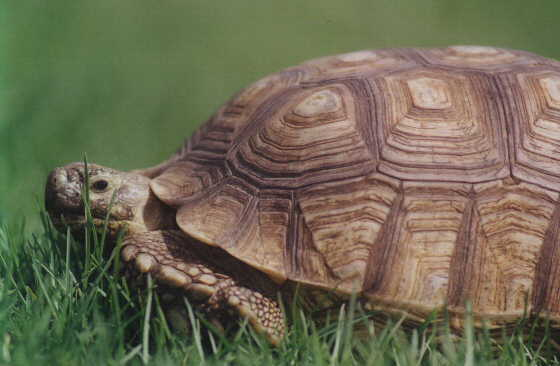General Information:
Sulcata tortoises live in the grasslands of Africa. Newly hatched tortoises typically measure 1-2 inches in diameter. When full grown, they can measure up to 3 feet in diameter and will weigh up to 150 pounds. They can live for over 100 years if cared for properly. This species of tortoise does not hibernate so they cannot be kept outdoors in climates where the temperature drops below 70 degrees or they will freeze to death. Hatchlings under 2 years should not be kept outdoors. These guys are enormous burrowers. They will dig tunnels up to 6 feet deep and 30 feet long if given the opportunity. For your tortoise's safely, chicken wire should be placed underground in their outdoor pen so they cannot dig these enormous burrows. This will prevent them from having the burrow collapse on them causing them to suffocate, and will also prevent them from escaping from your yard and being hit by cars or stolen, etc.
Housing:
In the wild, Sulcatas have a very large territory - they will roam an area of about 1 square mile. Keeping this in mind, you should try to provide them with as much space as possible. A minimum of a 20 gallon long tank can be used for a hatchling. A 1-2 year old tortoise requires a minimum of a 70 gallon tank or a large custom enclosure. At 2 years of age, your tortoise can move outside if you live in a warm climate, otherwise they will need a large warm basement, etc. to roam around in. Alfalfa pellets, hay, aspen bark, corn cob bedding, or reptile sand can be used for bedding. Do not use any type of humidity-holding bark such as pine or cypress - since the tortoises come from the dry desert/grasslands they are unable to tolerate humidity. Even small amounts of humidity (from a water bowl or moist bedding) can cause respiratory infections in Sulcata Tortoises. Do not keep a water bowl in the tank with your tortoise for this reason. Instead, take your tortoise out and soak him in a very shallow dish of warm water for about 30 minutes twice a week. Keep in mind these guys can't swim! They will sink like a rock if they are put in deep water. A 1/2 log or other hiding spot should be placed at one end of the tank. A pegboard or screen top should be placed on the cage. Do not put plastic or poisonous plants in the tank with your tortoise! They will try to eat them.
Heating and Lighting:
Two types of lighting will need to be turned on for 10-12 hours per day:
An incandescent light bulb should be placed on the top of the tank opposite the side with the hiding spot to provide your tortoise with a warm basking spot. Depending on the size of your tank and the temp in the room, anywhere from a 15 watt to a 75 watt bulb can be used. Place a thermometer under the bulb on the ground where your tortie will bask and make sure the temperature reaches 95-105 degrees when the light is on. If not, adjust the wattage of the bulb accordingly. A second thermometer should be placed at the other (cool) end of tank to make sure that side is at least 10-20 degrees cooler than the basking side so you don't cook your new pet! This light should be turned off for the night. However, if your house gets colder than 72 degrees at night, a black or blue light should be used to bring the temperature up to 75-80 degrees.
All day-moving reptiles, including Sulcata Tortoises, require a florescent UVA/UVB light. This light replicates the sun's rays which radiate vitamin D3, helping the animal to absorb calcium into their body. The light needs to be placed within 8-12 inches of the tortie's basking spot in order to be effective. The light should be replaced every 6-12 months. This light should be turned off for the night as well.
I do not recommend using any type of heating pad, hot rock, or anything other than an over-head heat source. Some people have had problems with their tortoises burning themselves on these types of heating elements. I am also a firm believer in replicating the natural environment as closely as possible. The heat from the sun comes from above, not from below. However, a flat piece of flagstone or other rock can be placed under the heat light if desired. It will warm in the light and provide a nice spot for your tortie to sprawl out.
Diet:
Sulcata Tortoises are strictly veggie eaters. Do not ever feed these guys insect or animal matter. Their digestive systems are not designed to process these types of foods. They need to get a large variety of grasses, dark leafy greens, fruits, and vegetables to be healthy. Their diet should consist of 80-90% grasses, hays and dark greens, 10-20% vegetables and fruits. Try things like collard greens, rye grass, clover, escarole, romaine, any type of grass, red or green-leaf lettuce, cabbage, timothy hay, alphalfa hay, dandelion greens, and the pre-cut variety packs of "baby greens" available at the grocery store. A lot of people plant different grass seeds in small shallow pans and then rotate them through the tank, allowing the tortie to graze from the growing seeds. Offer your tortoise berries, apples, peaches, beans, peas, carrots and as many different types of fruits and veggies as you can. Iceberg lettuce should NEVER be fed to any reptile. Rep-Cal Calcium and Multivitamin powder should be sprinkled over food 2-4 times per week.
General Care:
You should condition your tortoise's shell weekly with a shell conditioner available at most pet stores. This will keep the shell from getting dry and brittle and will prevent cracks.

